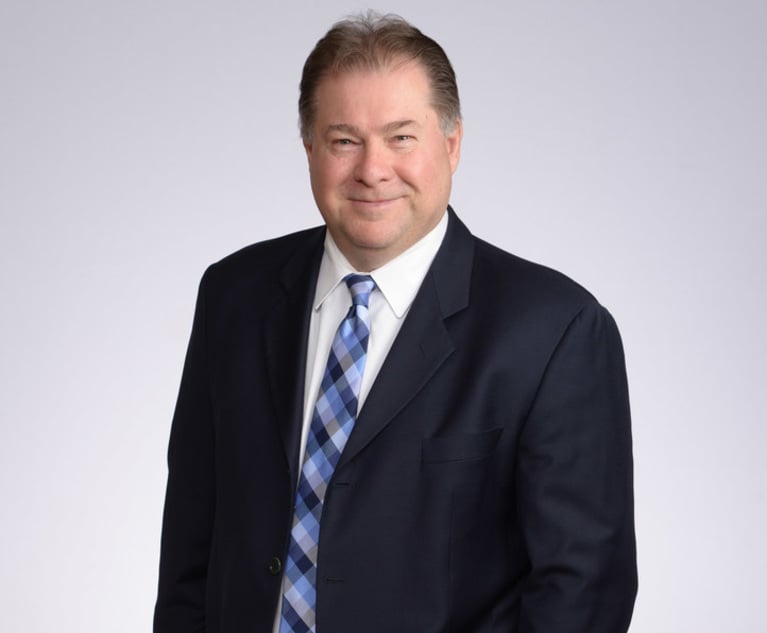 fatir29/Shutterstock.com
fatir29/Shutterstock.comAffidavits of Merit: Should They Be a Waste of Time?
It will come as no surprise to anyone who defends attorneys accused of malpractice that the Affidavit of Merit system is not working, at least as applied to the legal profession.
October 17, 2019 at 12:00 PM
6 minute read
It will come as no surprise to anyone who defends attorneys accused of malpractice that the Affidavit of Merit system is not working, at least as applied to the legal profession. In adopting the Affidavit of Merit Act, N.J.S.A. 2A:53A-26, et seq. (the "Act"), the legislature intended to weed out frivolous claims while permitting meritorious claims against professionals for malpractice or negligence to proceed. It did so by requiring early in a case that a plaintiff serve an affidavit by:
an appropriate licensed person that there is a reasonable probability that the care, skill or knowledge exercised … in the work that is the subject of the complaint, fell outside acceptable professional or occupational standards.
N.J.S.A. 2A:53A-7.
If an affidavit of merit (AOM) is not served within the prescribed time frame, the malpractice claim is to be dismissed with prejudice unless one of the judicially recognized exceptions applies; e.g., there has been "substantial compliance" or "extraordinary circumstances" are present. Ferreira v. Rancocas Orthopedic Assoc., 178 N.J. 144 (2003). Case law has also developed applying these exceptions; e.g., A.T. v. Cohen, 231 N.J. 337 (2017); Tischler v. Watts, 177 N.J. 243 (2002).
The courts, however, have not addressed in any published opinion what needs to be set forth in the AOM other than to recognize the affiant's qualifications need not be identified although the affiant must have the expertise to evaluate the attorney's malpractice, and the better practice is to identify those qualifications. Alan J. Cornblatt, P.A. v. Barow, 153 N.J. 218, 241 (1998). In this vacuum, the practice has developed that an AOM may be conclusory and simply parrot the language of the Act. As a result, the purpose of the Act—to weed out frivolous claims—is not achieved because there is no way a court or litigant can tell from the AOMs whether there is any merit to the underlying claim.
Today, AOMs often consist of the following conclusory statements: (a) the affiant has practiced law for at least five years; (b) he/she has reviewed "the file" or "certain [unspecified] documents"; and (c) "there exists a reasonable probability that the care, skill or knowledge exercised or exhibited in the practice or work of the attorneys referred to in the complaint fell outside acceptable professional standards." The latter is simply a recitation of the Act's operative language. The only substantive difference between AOMs often is the name of the defendant attorneys. The acts of malpractice are typically not identified, and no explanation of the basis for the opinion is provided.
AOMs are often produced by a handful of well-known attorneys who churn them out, sometimes at a significant flat fee. Other times, the affiant has little or no expertise in the subject matter where the malpractice was allegedly committed, but still delivers the AOM. Frequently, the affiant is not later designated as the expert for plaintiff.
Challenges to an AOM are to be made at a case management conference within 90 days of the answer being filed. Few challenges to the AOM are made at these Ferreira conferences because defendants have learned it is useless. Often, the trial court's response to a challenge is mechanical—as long as an attorney admitted to practice law in New Jersey for at least five years has signed the AOM and recited the statutory language, this is sufficient to satisfy the Act. Rarely does the court inquire about the substance of the opinion. It does not matter that the basis for the opinion is unstated, the act(s) of malpractice are not identified, or there is no basis to believe the affiant has expertise in the field. The AOM is nothing more than a box on the court's docket to be checked off.
The legislature did not intend this result when it adopted the Act to ferret out frivolous claims. It was the legislature's collective wisdom that such protection was necessary because too many frivolous malpractice claims were being filed, and the cost of defending such claims was substantial if these claims were treated by the judicial system like other forms of litigation. The protection against frivolous litigation afforded by Rule 1:4-8 alone was not regarded as sufficient by the legislature or governor.
The present practice, however, does not expose frivolous claims to permit their dismissal early in the litigation, but camouflages the claims until a much later time. Experience also suggests the affiant's opinion and the plaintiff's claim is intentionally hidden for strategic reasons, especially if the claim is problematic. While some may say the Act is bad policy or law, it is still a statute the legislature passed and the governor signed. As a result, it must be enforced in a manner that is consistent with the language and purpose(s) of the Act. Egan v. Erie R. Co., 29 N.J. 243, 252 (1959). Otherwise, the basic democratic principle that courts enforce laws passed by the legislature, has been eroded. Such an attitude should not be naïve or wrongheaded, if only because the same rules of statutory construction and enforcement apply to all legislation, regardless of whether we agree with the legislation or not. Egan, 29 N.J. at 252.
The Supreme Court has grappled with the Act over the past 25 years, Meehan v. Antonelles, 226 N.J. 216, 218 (2016), and it, or the Appellate Division, needs to address the Act again. The trial courts need guidance on what should be set forth in the AOM to weed out frivolous claims. It should not be sufficient that an attorney is willing to sign an affidavit reciting only the conclusion that there is a reasonable probability malpractice has occurred.
At a minimum, an AOM should identify: (a) the documents and information the affiant has considered in rendering the opinion; (b) the specific acts and omissions constituting malpractice; and (c) the basis for the conclusion that malpractice has occurred. Without this information available to the court, it cannot evaluate whether a claim is frivolous. The need to provide even this limited support also encourages a more meaningful review of the allegations of malpractice.
This should not suggest the AOM will be the equivalent of the expert report a plaintiff (or defendant) will have to serve ultimately in the case. Instead, it must provide sufficient information to the court to evaluate whether the claim has a meritorious basis. Nor will this spawn unnecessary motion practice because defendants will be encouraged to raise baseless objections to a more meaningful AOM. It does mean that if the plaintiff's AOM exposes the underlying claim as frivolous, there will likely be motion practice, as there should be, to determine if the claim should proceed. After all, this was the purpose of requiring AOMs and the cost of professional liability insurance has only risen since the Act was passed.
Michael K. Furey is a partner with Day Pitney LLP in Parsippany. He has a diverse practice, representing clients in commercial litigation and employment matters in federal and state courts.
This content has been archived. It is available through our partners, LexisNexis® and Bloomberg Law.
To view this content, please continue to their sites.
Not a Lexis Subscriber?
Subscribe Now
Not a Bloomberg Law Subscriber?
Subscribe Now
NOT FOR REPRINT
© 2025 ALM Global, LLC, All Rights Reserved. Request academic re-use from www.copyright.com. All other uses, submit a request to [email protected]. For more information visit Asset & Logo Licensing.
You Might Like
View All
New Methods for Clients and Families to Have Their Estate and Legacy Planning Complete
5 minute read
Tensions Run High at Final Hearing Before Manhattan Congestion Pricing Takes Effect
4 minute read

Appreciating the Important Work the Middlesex County Civil Bar Panel Does
7 minute readTrending Stories
- 12 Judges: Meet the New Chief Justice and the GC Who Just Rose to the Bench
- 2Holland & Knight Matches Milbank Bonuses for Some Associates
- 3Akin Promotes Record Number of Lawyers to Partner
- 4Ogletree Deakins Names 5 New Office Managing Shareholders
- 5Six Judges Take Up New Leadership Roles in NYC Courts
Who Got The Work
Michael G. Bongiorno, Andrew Scott Dulberg and Elizabeth E. Driscoll from Wilmer Cutler Pickering Hale and Dorr have stepped in to represent Symbotic Inc., an A.I.-enabled technology platform that focuses on increasing supply chain efficiency, and other defendants in a pending shareholder derivative lawsuit. The case, filed Oct. 2 in Massachusetts District Court by the Brown Law Firm on behalf of Stephen Austen, accuses certain officers and directors of misleading investors in regard to Symbotic's potential for margin growth by failing to disclose that the company was not equipped to timely deploy its systems or manage expenses through project delays. The case, assigned to U.S. District Judge Nathaniel M. Gorton, is 1:24-cv-12522, Austen v. Cohen et al.
Who Got The Work
Edmund Polubinski and Marie Killmond of Davis Polk & Wardwell have entered appearances for data platform software development company MongoDB and other defendants in a pending shareholder derivative lawsuit. The action, filed Oct. 7 in New York Southern District Court by the Brown Law Firm, accuses the company's directors and/or officers of falsely expressing confidence in the company’s restructuring of its sales incentive plan and downplaying the severity of decreases in its upfront commitments. The case is 1:24-cv-07594, Roy v. Ittycheria et al.
Who Got The Work
Amy O. Bruchs and Kurt F. Ellison of Michael Best & Friedrich have entered appearances for Epic Systems Corp. in a pending employment discrimination lawsuit. The suit was filed Sept. 7 in Wisconsin Western District Court by Levine Eisberner LLC and Siri & Glimstad on behalf of a project manager who claims that he was wrongfully terminated after applying for a religious exemption to the defendant's COVID-19 vaccine mandate. The case, assigned to U.S. Magistrate Judge Anita Marie Boor, is 3:24-cv-00630, Secker, Nathan v. Epic Systems Corporation.
Who Got The Work
David X. Sullivan, Thomas J. Finn and Gregory A. Hall from McCarter & English have entered appearances for Sunrun Installation Services in a pending civil rights lawsuit. The complaint was filed Sept. 4 in Connecticut District Court by attorney Robert M. Berke on behalf of former employee George Edward Steins, who was arrested and charged with employing an unregistered home improvement salesperson. The complaint alleges that had Sunrun informed the Connecticut Department of Consumer Protection that the plaintiff's employment had ended in 2017 and that he no longer held Sunrun's home improvement contractor license, he would not have been hit with charges, which were dismissed in May 2024. The case, assigned to U.S. District Judge Jeffrey A. Meyer, is 3:24-cv-01423, Steins v. Sunrun, Inc. et al.
Who Got The Work
Greenberg Traurig shareholder Joshua L. Raskin has entered an appearance for boohoo.com UK Ltd. in a pending patent infringement lawsuit. The suit, filed Sept. 3 in Texas Eastern District Court by Rozier Hardt McDonough on behalf of Alto Dynamics, asserts five patents related to an online shopping platform. The case, assigned to U.S. District Judge Rodney Gilstrap, is 2:24-cv-00719, Alto Dynamics, LLC v. boohoo.com UK Limited.
Featured Firms
Law Offices of Gary Martin Hays & Associates, P.C.
(470) 294-1674
Law Offices of Mark E. Salomone
(857) 444-6468
Smith & Hassler
(713) 739-1250






